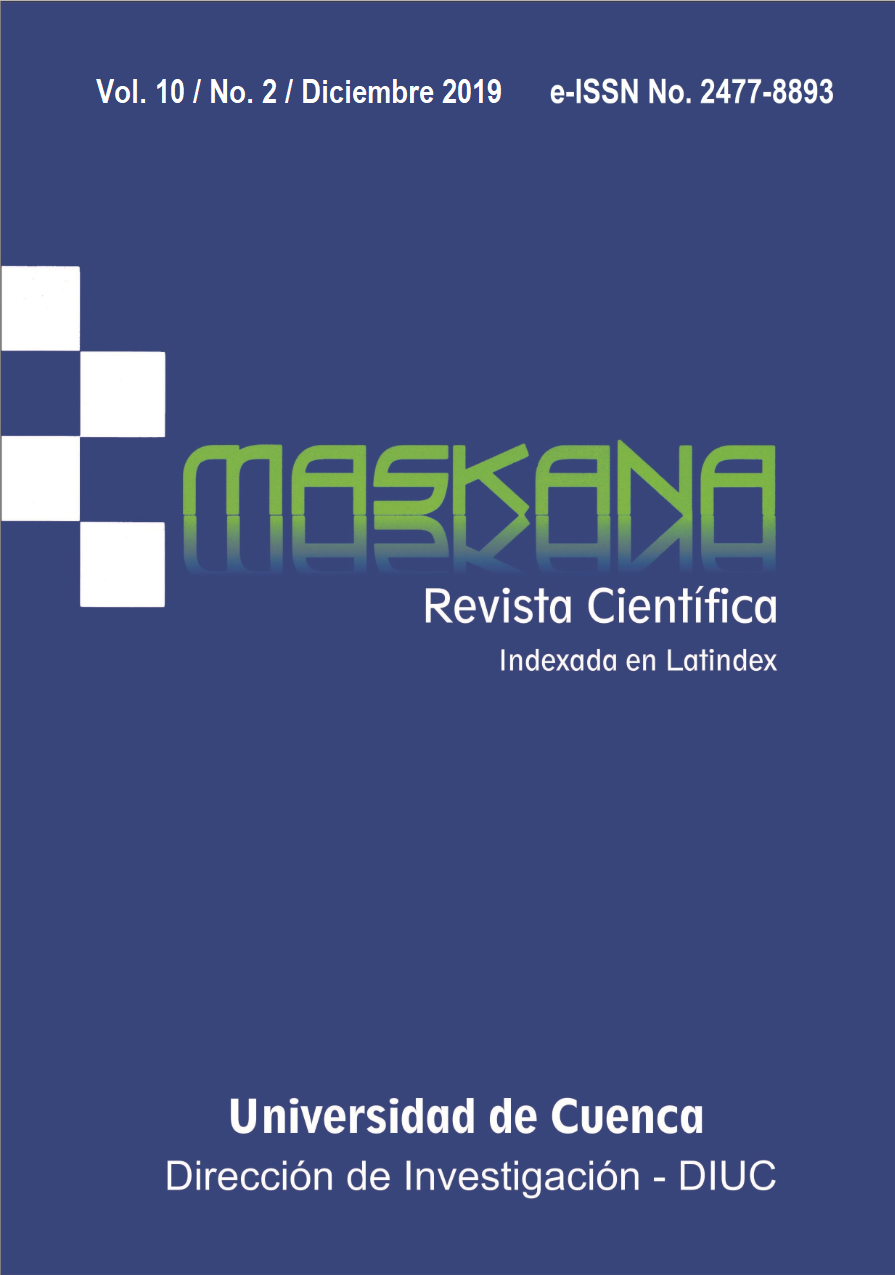Evaluation of the global spatiotemporal change in the South Department of Haiti, from 1973 to 2017
DOI:
https://doi.org/10.18537/mskn.10.02.05Keywords:
Global Change, Land cover change, Remote Sensing, HaitiAbstract
Haiti as a country faces great environmental and societal challenges. Haiti is characterized by a high deforestation, lack of territorial planning, political and economic instability, and a growing population exerting pressure on natural resources. In this article, we analyze the historic land cover change in the Southern Department of Haiti from 1973 to 2017 and the relationship to socioeconomic and biophysical variables. All variables under change together are considered as the holistic definition of global change. We used Landsat satellite images, public data repositories and statistical correlations to analyze the directionality of the above-mentioned global change in Haiti. The results showed a marked fluctuation of crop areas, a relation of bare soil with deforested areas, as well as a decrease in forest cover after a series of hydrometeorological and sociopolitical events. In addition, we found that changes in brush area were significantly associated with the rates of change in population, temperature and the Human Development Index (HDI), while the rate of change in rainfall significantly influenced the change in crop coverage. On the other hand, changes in bare soil had a significant relationship with the rate of population change. Finally, none of the variables considered was significantly correlated with the spatiotemporal change of urban and forest coverage.
Downloads
Metrics
References
Administración Nacional Oceánica y Atmosférica, NOAA. (2017). Climate data repository. U.S. Department of Commerce. https://www.noaa.gov/
Agencia Suiza para Desarrollo y Cooperación, CONSUDE. (2016). Preservación del bosque de los pinos en Haití: Haití: Salvar los árboles - mejorar las vidas. Latin Brief, 2, 4 pp. Disponible en: https://www.eda.admin.ch/dam/deza/es/documents/publikationen/briefing-papers/latin-brief-haiti-160615_ES.pdf
Ayala, R. M., & Menenti, M. (2001). Metodología para la búsqueda del mejor clasificador de imágenes de satélite. Teledetección, Medio Ambiente y Cambio Global, 469-472. Disponible en: http://www.aet.org.es/congresos/ix/Lleida103.pdf
Banco Mundial. (2017). Haití. Disponible en: http://datos.bancomundial.org/pais/haiti
Banskota, A., Kayasthan, N., Falkowski, M. J., Wulder, M. A., Froese, R. E., & White, J. C. (2014). Forest monitoring using Landsat time series data: A review. Canadian Journal of Remote Sensing, 40(5), 362-384. doi.org/10.1080/07038992.2014.987376
Barthelemy, M., & Barthelemy, C. (2003). Haïti, la perle nue. Vents d’ailleurs, France.
Carr, D. L. (2004). Factores demográficos proximales y deforestación en las fronteras agrícolas tropicales. Population and Environment, 25(6), 1-41.
Chávez, P. S. (1988). An improved dark-object subtraction technique for atmospheric scattering correction of multispectral data. Remote Sensing of Environment, 24(3), 459-479. https://doi.org/10.1016/0034-4257(88)90019-3
Churches, C. E., Wampler, P. J., Sun, W., & Smith, A. J. (2014). Evaluation of forest cover estimates for Haiti using supervisedclassification of Landsat data. International Journal of Applied Earth Observation and Geoinformation, 30, 203-216. https://doi.org/10.1016/j.jag.2014.01.020
Chuvieco, E. (2002). Teledetección Ambiental. Barcelona, España: Editorial Ariel.
D’Annunzio, R., Lindquist, E. & MacDicken, K. (2017). Global forest land-use change from 1990 to 2010: An update to a global remote sensing survey of forests. Forest Resources Assessment Working Paper, 187, 1-14. Disponible en: http://www.fao.org/3/a-i5098e.pdf
DeFries, R. S., Rudel, T., Uriarte, M., & Hansen, M. (2010). Deforestation driven by urban population growth and agricultural trade in the twenty-first century. Nature Geoscience, 3, 178-181. doi:10.1038/NGEO756
Departamento de Asuntos Económicos y Sociales, DAES. (2017). World Population Prospects: The 2017 Revision. Organización de Naciones Unidas. Nueva York. Disponible en: https://population.un.org/wpp/Publications/Files/WPP2017_KeyFindings.pdf
Di Martino, G., Iodice, A., Pansera, M., Riccio, D., & Ruello, G. (2007). Remote sensing for developing countries: Landsat data and Gis. Rivista Italiana di Telerilevamento, 38, 3-13. Disponible en: http://wpage.unina.it/gerardo.dimartino/papers/DiMartino.pdf
Duarte, C. M. (coord.) et al. (2006). Cambio global: Impacto de la actividad humana sobre el sistema Tierra. Consejo Superior de Investigaciones Científicas. Madrid, España. Disponible en: http://digital.csic.es/bitstream/10261/27310/1/cambioGlobal.pdf, 170 pp.
EcuRed. (2015). Desastres naturales en Haití. Disponible en: https://www.ecured.cu/ Desastres_naturales_en_Hait%C3%AD.
Equihua Zamora, M., Hernández Huerta, A., Pérez Maqueo, O., Benítez Badillo, G., & Ibañez Bernal, S. (2015). Cambio global: el Antropoceno. Ciencia Ergo-sum, 23(1), 67-75. Disponible en: https:// dialnet.unirioja.es/descarga/articulo/5379210.pdf
Falcón, O. (2014). Dinámica de cambio de uso/cobertura del suelo, en una región del Estado de Quintana Roo, México: El impacto de las políticas gubernamentales sobre el Manejo Forestal Comunitario (Tesis de grado). Universidad Autónoma de México. Disponible en: http:// 132.248.9.195/ptd2014/enero/0707773/0707773.pdf
Fern. (2017). Tackling deforestation and forest degradation: a case for EU action in 2017. Disponible en: https://www.forestpeoples.org/ sites/default/files/documents/deforestation-4.pdf
Geist, H. J., & Lambin, E. F. (2001). What drives tropical deforestation? A meta-analysis of proximate and underlying causes of deforestation based on subnational case study evidence. LUCC Report Series 4, 136 pp. CIACO, Universidad de Louvain, Louvain-la-Neuve, Bélgica. Disponible en: https://www.pik-potsdam.de/members/cramer/ teaching/0607/Geist_2001_LUCC_Report.pdf
González, M., & Manero, A. (2011). El conflicto de Haití. Conflictos Internacionales Contemporáneos. 291 pp. https://publicaciones.defensa.gob.es/el-conflicto-de-haiti.html
Haïti-Référence. (2016). Catastrophes Naturels: Cyclones y Ouragans. Disponible en: https://www.haiti-reference.com/pages/plan/ geographie-et-tourisme/milieu-naturel/desastres-et-accidents/cyclones-et-ouragans/
Houghton, R. (1994). The worldwide extent of land-use change. BioScience, 4(5), 305-313. https://doi.org/10.2307/1312380
Jeune, W., de Souza, E., Rocha Franceline, M., Fernandes Filho, E. I., & Crusoé Rocha, G. (2018). Land use and land cover dynamics in western Haiti. In: 21WCSS: Proceedings of the 21st World Congress of Soil Science, 2018, August 12-17; Rio de Janeiro, Brazl: SBCS, Vol. II, p. 393. Disponible en: http://www.21wcss.org/docs/ Proceedings_of_the_21WCSS_Volume_II.pdf
Klein-Goldewijk, K., & Ramankutty, N (2010). Land use changes during the past 300 years. Land use, land cover and soil sciences, 1, 22 pp. Disponible en: https://www.researchgate.net/publication/ 242217587_Land_use_changes_during_the_past_300_years
Lambin, E. F., Turner, B. L., Geist, H. J., Agbola, S. B., Angelsen, A., …, et al. (2001). The causes of land-use and land-cover change: moving beyond the myths. Global Environmental Change, 11(4), 261-269. https://doi.org/10.1016/S0959-3780(01)00007-3
Lambin, E., & Geist, H. (Eds.) (2006). Land-use and land-cover change: Local processes and global impacts. Springer, Alemania.
Lambin, E., & Meyfroidt, P. (2011). Global land use change, economic globalization, and the looming land scarcity. PNAS, 8(9) 3465-3472. https://doi.org/10.1073/pnas.1100480108
Lambin, E., Geist, H., & Lepers, E. (2003). Dynamics of land use and land cover change in tropical regions. Annual Review of Environment y Resources, 28, 205-245. doi:10.1146/annurev.energy.28.050302.105459
López, V. H., Balderas, M. A., Chávez, M. C., Juan, J. I., & Gutiérrez, J. G. (2014). Cambio de uso de suelo e implicaciones socioeconómicas en un área mazahua del altiplano mexicano. CIENCIA ergo-sum, 22(2) 136-144. Disponible en: https://dialnet.unirioja.es/ descarga/articulo/5116566.pdf
Martínez, M. (2005). Percepción Remota: Fundamentos de Teledetección espacial. México: Comisión Nacional de Agua Subdirección General de Programación, Subgerencia de Informática y Sistema Geográfico del Agua. Jefatura de Control Cartográfico. Disponible en: http://siga.cna.gob.mx/ SIGA/Percepcion/Fundamentos%20de%20teledetecci%C3%B3n%20espacial.PDF
Mas, J-F., Velázquez, A., Díaz-Gallegos, J. R., Mayorga-Saucedo, R., Alcántara, C., …, et al. (2004). Assessing land use/cover changes: a nationwide multidate spatial database for Mexico. International Journal of Applied Earth Observation and Geoinformation, 5(4), 249-261. https://doi.org/10.1016/j.jag.2004.06.002
Mas, J., Velázquez, A., & Couturier, S. (2009), La evaluación de los cambios de cobertura/uso del suelo en la República Mexicana. Investigación Ambiental, 1(1), 23-39.
Meyer, W., & Turner, B. (2002). The Earth transformed: trends, trajectories and patterns. En: Johnston R., Taylor, P., & Watts, M. (Eds.). Geographies of global change: Remapping the world (2ª ed.) (pp. 364-376). UK, Oxford: Blackwell.
Nazareno, M. (2014). Métodos de clasificación de imágenes satelitales para la determinación de usos del suelo agrícola en el Partido de Tandil (Provincia De Buenos Aires, Argentina). Universidad Nacional del Centro de la Provincia de Buenos Aires. Disponible en: http://www.formagro.com/ recursos/descargas/Metodos-de-clasificacion-digital-de-imagenes-satelitales-para-clasificacion-de-uso-de-suelos.pdf
Ponce-Opazo, B. (2010). Detección y análisis del cambio de uso del suelo en la zona centro - norte de la provincia de Capitán Prat, XI Región período 1984-2003. Tesis de grado, Facultad de Ciencias Forestales y Recursos Naturales, Universidad Austral de Chile, Valdivia, Chile. Disponible en: http://cybertesis.uach.cl/tesis/uach/2010/fifp792d/doc/fifp792d.pdf
Pramanik, M. (1993). Satellite remote sensing and its application to the needs of developing countries: An Asian perspective. Selected Papers on Remote Sensing, Satellite Communications, and Space Science. Seminars of the United Nations Program on Space Applications, Vol. 4, 145-156. Disponible en: http://adsabs.harvard.edu/full/1993UNPSA...4..145P
Programa de las Naciones Unidas para el Ambiente. (2013). Haití-República Dominicana: Desafíos ambientales en la zona fronteriza. Nairobi, Kenia: Programa de las Naciones Unidas para el Medio Ambiente. Disponible en: https://postconflict.unep.ch/publications/UNEP_Haiti-DomRep_border_zone_SP.pdf
Rindfuss, R. R., Entwisle, B., Walsh, S. J., An, L., Badenoch, N., …, et al. (2015). Land use change: complexity and comparisons. Journal of Land Use Science, 3(1), 1-10. https://doi.org/10.1080/17474230802047955
Rounsevell, M. (2006). Global environmental change. En: Geist, H. (Ed.), Our Earth´s Changing Land: An Encyclopedia of Land-Use and Land-Cover Change (pp. 254-256). Estados Unidos: Greenwood Publishing Group.
Ruiz, V., Savé, R., & Herrera, A. (2013). Análisis multitemporal del cambio de uso del suelo, en el Paisaje Terrestre Protegido Miraflor Moropotente Nicaragua, 1993-2011. Ecosistemas, 22(3), 117-123. doi: 10.7818/ECOS.2013.22-3.16
Sacristán, F. (2006). La teledetección satelital y los sistemas de protección ambiental. AquaTIC, 24, 13-41. Disponible en: http://www.revistaaquatic.com/aquatic/pdf/24_02.pdf
Taubert, F., Fischer, R., Groeneveld, J., Lehmann, S., Müller, M. S., …, et al. (2018). Global patterns of tropical forest fragmentation. Nature, 554, 519-522. doi:10.1038/nature25508
Tovar, W. (2013). Propuesta de clasificación de cobertura/uso de la tierra en los Andes. Caso: cuenca del río Grita, Venezuela. Tesis de grado, Instituto de Ciencias Ambientales y Ecológicas (ICAE), Universidad de Los Andes, Venezuela. Disponible en: http://www.saber.ula.ve/bitstream/ 123456789/39866/1/Tovar2013.pdf
Turner, B. (1988). The earth as transformed by human action. The Professional Geographer, 40(3), 340-341. https://doi.org/10.1111/j.0033-0124.1988.00340.x
Veldkamp, A., & Lambin, E. (2001). Predicting land-use change. Agriculture, Ecosystems and Environment, 85, 1-6. doi:10.1016/S0167-8809(01)00199-2
Versluis, A., & Rogan, J. (2009). Mapping land-cover change in a Haitian watershed using a combined spectral mixture analysis and classification tree procedure. Geocarto International, 25, 1-19. doi:10.1080/10106040902977584
Vital, J. (2008). Land Use/Cover Change Using Remote Sensing and Geographic Information Systems: Pic Macaya National Park, Haiti. Master’s Thesis, Michigan Technological University, 2008. https://digitalcommons.mtu.edu/etds/138
Vitale, L. (1987). Haití: Primera nación independiente de América Latina. Revista EDM, 43. Disponible en: https://revistaedm.com/verNotaRevistaTeorica/516/haiti-primera-nacion-independiente-de-america-latina
WaterClima-LAC. (2017). Proyecto Piloto B. Aquin, Zona Costera Sur de Haití (Caribe). EuropeAid Project.
Watson, R. T., Noble, I. R., Bolin, B., Ravindranath, N. H., Verardo, D. J., & Dokken, D. J. (Eds.) (2000). Land Use, Land Use Change and Forestry. Cambridge, England: Cambridge University Press. Pp. 875. Disponible en: https://www.ipcc.ch/report/ land-use-land-use-change-and-forestry/
Zondag, B., & Borsboom, J. (2009). Driving forces of land-use change. 49th ERSA Conference, Lodz, Poland, 1-16. Disponible en: https://www.researchgate.net/publication/285854006_ Driving_forces_of_land-use_change
Published
How to Cite
Issue
Section
License
Copyright © Autors. Creative Commons Attribution 4.0 License. for any article submitted from 6 June 2017 onwards. For manuscripts submitted before, the CC BY 3.0 License was used.
![]()
You are free to:
 |
Share — copy and redistribute the material in any medium or format |
 |
Adapt — remix, transform, and build upon the material for any purpose, even commercially. |
Under the following conditions:
 |
Attribution — You must give appropriate credit, provide a link to the licence, and indicate if changes were made. You may do so in any reasonable manner, but not in any way that suggests the licenser endorses you or your use. |
| No additional restrictions — You may not apply legal terms or technological measures that legally restrict others from doing anything the licence permits. |






